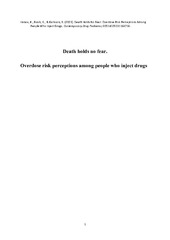| dc.contributor.author | Hanoa, Kristin | |
| dc.contributor.author | Buvik, Kristin | |
| dc.contributor.author | Karlsson, Bengt Eirik | |
| dc.date.accessioned | 2023-05-22T12:26:51Z | |
| dc.date.available | 2023-05-22T12:26:51Z | |
| dc.date.issued | 2023-04-12 | |
| dc.description.abstract | Drug overdose is an important public health problem. Despite well-known risk factors and various preventive measures, the overdose mortality rate has increased substantially in several countries worldwide over the past decade. There is therefore a need to understand overdoses on the basis of how people who inject drugs (PWID) perceive and experience risk. Based on qualitative interviews with 80 PWID recruited from low-threshold settings in Norway, this study explores the complex lived experiences and perceptions of overdose. The qualitative approach is sensitive towards lived experiences and provides new understandings of overdoses. The analysis revealed three types of accounts concerning perceived overdose risk. First, interviewees described death as natural and not frightening, based on perceptions of death as universal, a part of their high-risk lifestyle and their previous overdose experiences. Second, they presented accounts of how they perceived others to be at greater risk of overdose than themselves, in respect of experience, skills and tolerance. Finally, interviewees described an indifference towards death, on a continuum between the wish to live and death as relief from various life challenges. This study illustrates how PWID inhabit drug-using environments which entail a high-risk lifestyle. Faced with these risks, the interviewees presented stories which may serve several functions, such as neutralizing feelings of risk and stigma and gaining a sense of agency and control. They also created symbolic boundaries in order to form positive perceptions of self, by distancing themselves from other stereotypical people who use drugs. The participants additionally expressed an indifference towards overdose death. This may entail that avoiding death, the main rationale of overdose interventions, is viewed with indifference by some PWID. This is important for understanding the complexity of overdose mortality and should be reflected in future harm-reduction initiatives. | en_US |
| dc.identifier.citation | Hanoa K, Buvik K, Karlsson BE. Death Holds No Fear: Overdose Risk Perceptions Among People Who Inject Drugs. Contemporary Drug Problems. 2023:1-16 | en_US |
| dc.identifier.cristinID | FRIDAID 2140767 | |
| dc.identifier.doi | 10.1177/00914509231164764 | |
| dc.identifier.issn | 0091-4509 | |
| dc.identifier.issn | 2163-1808 | |
| dc.identifier.uri | https://hdl.handle.net/10037/29253 | |
| dc.language.iso | eng | en_US |
| dc.publisher | SAGE Publications | en_US |
| dc.relation.journal | Contemporary Drug Problems | |
| dc.rights.accessRights | openAccess | en_US |
| dc.rights.holder | Copyright 2023 The Author(s) | en_US |
| dc.rights.uri | https://creativecommons.org/licenses/by/4.0 | en_US |
| dc.rights | Attribution 4.0 International (CC BY 4.0) | en_US |
| dc.title | Death Holds No Fear: Overdose Risk Perceptions Among People Who Inject Drugs | en_US |
| dc.type.version | acceptedVersion | en_US |
| dc.type | Journal article | en_US |
| dc.type | Tidsskriftartikkel | en_US |
| dc.type | Peer reviewed | en_US |


 English
English norsk
norsk
